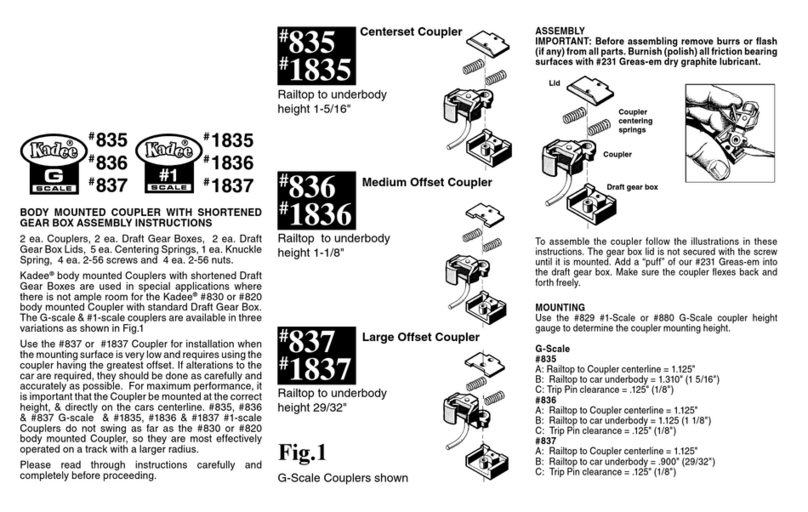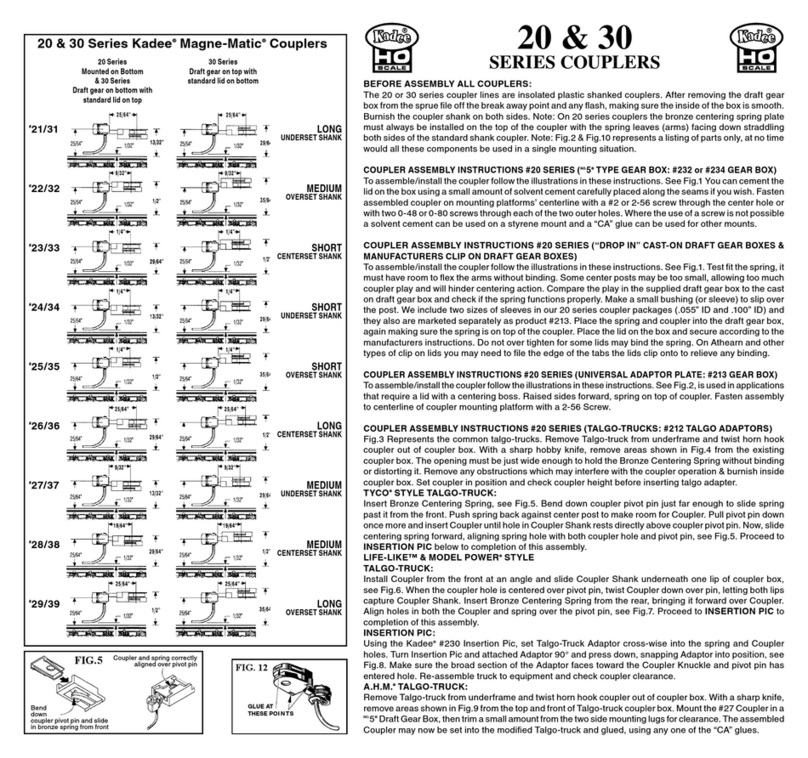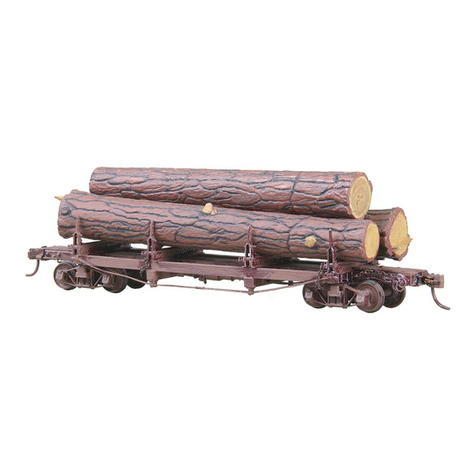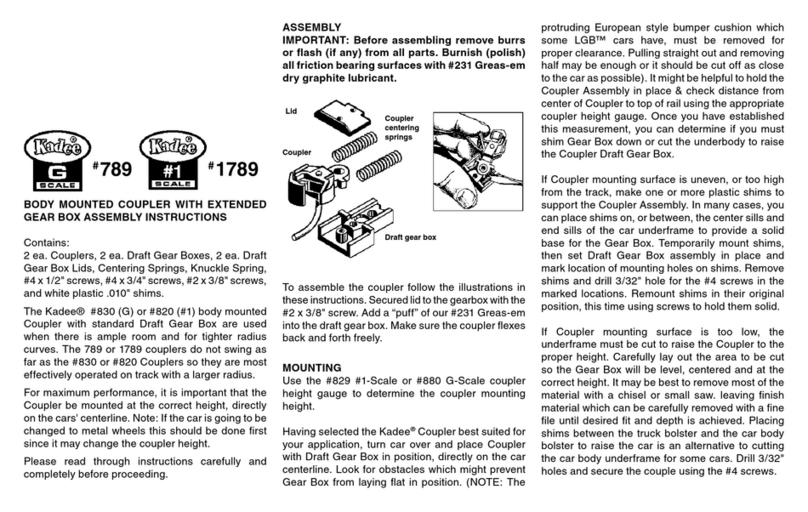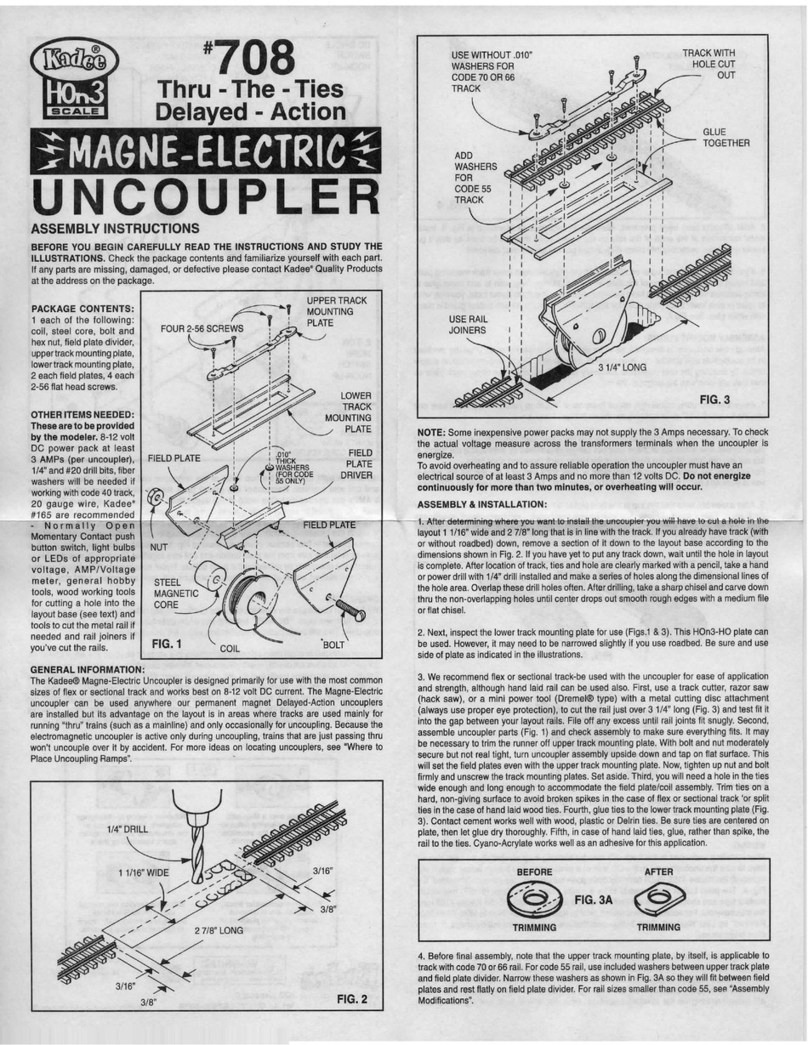
3. Place glued end
over the knuckle
retaining post and
then compress
spring so that it
may slip over the
opposing shank
retaining post. See
Fig. 3.
4. Carefully
remove pic from
spring.
Fig. 2.
673 Avenue C
White City,
Oregon
97503- 1078 U.S.A.
© 2008 Kadee
®
Quality Products Co. 62008
Fig. 3.
GLUING INSERT
To prevent losing knuckle springs by being
dislodged use the following steps and supplies.
Kadee®#241 Dual Tool (Manual Uncoupling Tool
& Spring Pic), small piece of blue denim cloth,
DUCO®CEMENT or WALT HERS®GOO®,or
similar type cement. CAUTION: Always follow
safety instructions for the cement that you may
be using.
1. To pick up spring place it on the cloth (this
allows the small springs to be seen and picked
up easier) and insert
#241 Dual Tool (Manual
Uncoupling Tool & Spring
Pic) into spring between
coils near one end. See
Fig. 1.
2. Touch one end of the spring into the cement
so that no more than one or two coils are
coated (too much cement will hamper coupler
performance). See Fig. 2.
Fig. 1.
WARNING:
CHOKING HAZARD - Small Parts
Not for children under 14 years.
Made Entirely
in the U.S.A.
071310
673 Avenue C,
White City, OR 97503-1078 © 2010, Kadee®Quality Products Co.
Quality Products Co.
STAKES ...
A piece of chain 1 7/8” long is attached to each stake, and this can best
be accomplished by suspending the chain from a fixed position in such
a way that one end will hang free, thus leaving both hands available for
the attachment. Fig.12 shows one satisfactory method, which can be
employed. A small clamp type tweezer, such as made by X-acto®, is held
by burying the handle end In a lump
of modeling clay while the chain is
gripped so one end hangs free. Now
hold the stake up to the chain with the
last link entered between the stake
legs and centered between the holes.
Next feed a length of wire through the
stake leg on one side, then through the
end chain link, and finally through the
opposite stake leg.
Flatten one end of the wire by
squeezing between jaws of a pair
of pliers. Trim this flattened end, as
shown by dashed lines on flattened
wire (inset Fig. 13), but leave sufficient
flare to prevent the wire pulling back
through the stake. Push this flattened
end as close as possible to the stake
side while other end of wire is trimmed close to the stake on its side. Repeat
the flattening process once again with pliers and trim as recommended
for the first side. The objective is to have as little excess wire as possible
extending beyond the stakes sides, otherwise stakes will not fit down
between the bunk sides when
car is unloaded and they are in
the down position.
small wire loop having two free
ends, the ends must be spread
apart and inserted through the
end link of stake chain, one ring
for each stake chain. Fig. 14
shows how NOT to spread this
ring, Instead, foil on the direction
of the arrows In Fig. 15 to spread
ring ends Sideways after the
fashion of a split look washer.
After inserting ring through chain
link, close ring ends “together
again, following this method the
circular appearance of the ring
is not so likely to be distorted.
STAKE TO BUNK ...
Insert small plastic bushing between legs of stakes and center over holes
on the lower end of stake. Using wire provided, push a length of wire through
hole in bunk end, through the bushing In stake and out through the other
side of the bunk using pliers to force the wire through with a twisting motion.
The wire is a snug fit In the bushing so this friction will keep the wire In
place permanently. Trim wire close to bunk sides and proceed with other
three stakes. Placement of these parts is shown In Fig. 18.
Once stakes are in place, feed free end of stake chains through side
openings in bunk opposite from where stake is located. This is shown in
Fig. 19 where only one stake and chain assembly is shown for sake of
clarity. On the original log cars, to hold a load of logs, stakes must be near
vertical and they are prevented from failing outwards by adjusting the chain
length on the opposite side of the bunk.
At this point chain links are caught between two vertical projections on
a small bracket on bunk side. The stakes on our models have elongated
pivot holes and locking dogs on their lower ends, which when pushed
down in the vertical position, locks against the bunks, preventing them from
failing outwards. Pulling upwards releases the dogs and allows them to
fall inwards as well as outwards. See Fig. 18 for clarification. See Fig. 16
and note how excess chain drapes downward from the bracket and Is then
brought back up to place grab ring over a third outer lug on the bracket.
FINAL ASSEMBLY ...
Before trucks are fastened in
place, install air lines “S” in
position, one on each end of
car. Cement straight end of
wire “S” into the hole of the
end casting, the opposite end
fits into a pre-cast hole in car
body as shown in Fig. 17. On
extremely sharp radius curves
the wheel could possibly rub
against air line “S”, but this
problem can be alleviated
by cutting the wire shorter,
replacing the correct bend
and cementing it into a hole
that can be drilled about 1/8”
ahead of existing hole. This
will allow greater truck swing
and consequently permits
operation over sharper radius
curves. Now capture the end
link of the 5/8” chain, from
brake wheel, with the looped
end of brake rod “G”. Close
the loop with pliers to secure
the chain. Before pressing
the bunks into place, this rod
must pass through an opening
on the underside of bunk, as
seen in Fig. 17. Once this rod
is passed through this space, press bunks into place, center stud of bunk
passing through car body as shown in Fig. 19. Insert 2 - 56 truck mounting
screw up through center of truck bolster and place kingpin bearing plate
over this screw and down into truck kingpin hole. Screw truck up into bunk
center but allow sufficient play here so trucks will swing freely. The opposite
end of rod “G” now cements into clevis on brake lever “C” (see Fig.7).
Note: the outer undersides of the bunks have bearing plates (T) that slide
on the tops of truck bolsters (V) as truck pivots. This, of course, is to bear
the weight of log load as it tends to tip on curves.
Where the model is intended to run on extremely sharp radius track
curves, It is possible the truck bolster will bypass bunk bearing
plates, thus when the truck straightens out again there could be a
stubbing or jamming action at this point. This can be overcome by
slightly rounding the tops of trucks bolsters (at V) with a few light
file strokes as shown in enlarged view (Inset) in Fig. 19.
To complete the model, add air hose and glad hand (W) by cementing
into outer side of hole found in end casting. This is same opening
wire air line “S” enters from rear (see Flg. 17).
R
Fig. 9
Fig. 8
Fig. 12
Fig. 14 Fig. 15
G
SW
shorten for sharp
radius curves
Fig. 18
Fig. 17
Fig. 16
chain
omitted
coupler
omitted
for
clarity
T
V
Fig. 19
coupler and end
casting omitted
kingpin
bearing plate
pin draft gear to
end casting here
